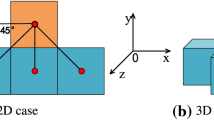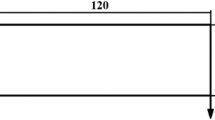Abstract
The self-supporting requirement is very necessary in additive manufacturing so that the printed structure will not collapse during fabrication. Imposing the self-supporting constraint on topology optimization allows for designing a performance optimized structure that is ready-to-print. However, although biscale topology optimization has been widely studied, conducting self-supporting topology optimization separately for the macro-structure and for each micro-structure is not sufficient to produce an overall self-supporting structure, as first observed in this study. The issue is resolved via an approach to bridge the gap between the requirements of self-supporting at the two scales via distinguishing the macro-cells based on their relative locations. In addition, the self-supporting constraint is expressed as a simple quadratic function included in the topology optimization in both scales, and a convolution operator is designed to efficiently implement its detection. Ultimately, a completely self-supporting overall structure is generated within a biscale topology optimization framework and extends its potentiality to produce design to be directly fabricated via additive manufacturing. Performance of the approach is demonstrated via various 2D and 3D examples.




















Similar content being viewed by others
References
Langelaar, M.: An additive manufacturing filter for topology optimization of print-ready designs. Struct. Multidiscip. Optim. 55, 1–13 (2016)
Langelaar, M.: Topology optimization of 3D self-supporting structures for additive manufacturing. Addit. Manuf. 12, 60–70 (2016)
Daniel, T.: The development of design rules for selective laser melting, University of Wales, Cardiff (2009)
Majhi, J., Janardan, R., Schwerdt, J., Smid, M., Gupta, P.: Minimizing support structures and trapped area in two-dimensional layered manufacturing. Comput. Geom. 12(3–4), 241–267 (1999)
Vanek, J., Galicia, J., Benes, B.: Clever support: efficient support structure generation for digital fabrication. Comput. Graph. Forum 33(5), 117–125 (2014)
Wang, C., Chen, Y.: Thickening freeform surfaces for solid fabrication. Rapid Prototyp. J. 19(6), 395–406 (2013)
Dumas, J., Hergel, J., Lefebvre, S.: Bridging the gap: automated steady scaffoldings for 3D printing. ACM Trans. Graph. 33(4), 1–10 (2014)
Wu, J., Wang, C.C., Zhang, X., Westermann, R.: Self-supporting rhombic infill structures for additive manufacturing. Comput. Aided Des. 80, 32–42 (2016)
Hu, K., Jin, S., Wang, C.C.: Support slimming for single material based additive manufacturing. Comput. Aided Des. 65, 1–10 (2015)
Brackett, D., Ashcroft, I., Hague, R.: Topology optimization for additive manufacturing. In: Proceedings of the Solid Freeform Fabrication Symposium, Austin, TX, pp. 348–362 (2011)
Gaynor, A.T., Guest, J.K.: Topology optimization for additive manufacturing: considering maximum overhang constraint. In: 15th AIAA/ISSMO Multidisciplinary Analysis and Optimization Conference, pp. 16–20 (2014)
Qian, X.: Undercut and overhang angle control in topology optimization: a density gradient based integral approach. Int. J. Numer. Meth. Eng. 111(3), 247–272 (2017)
Guo, X., Zhou, J., Zhang, W., Du, Z., Liu, C., Liu, Y.: Self-supporting structure design in additive manufacturing through explicit topology optimization. Comput. Methods Appl. Mech. Eng. 323, 27–63 (2017)
Huang, X., Zhou, S.W., Xie, Y.M., Li, Q.: Topology optimization of microstructures of cellular materials and composites for macrostructures. Comput. Mater. Sci. 67, 397–407 (2013)
Yan, X., Huang, X., Zha, Y., Xie, Y.M.: Concurrent topology optimization of structures and their composite microstructures. Comput. Struct. 133(3), 103–110 (2014)
Bendsoe, M.P., Kikuchi, N.: Generating optimal topologies in structural design using a homogenization method. Comput. Methods Appl. Mech. Eng. 71(2), 197–224 (1988)
Bendsoe, M.P.: Optimal shape design as a material distribution problem. Struct. Optim. 1(4), 193–202 (1989)
Xie, Y.M., Steven, G.P.: A simple evolutionary procedure for structural optimization. Comput. Struct. 49(5), 885–896 (1993)
Huang, X., Xie, Y.M.: A further review of ESO type methods for topology optimization. Struct. Multidiscip. Optim. 41(5), 671–683 (2010)
Wang, M.Y., Wang, X., Guo, D.: A level set method for structural topology optimization. Adv. Eng. Softw. 192(1), 227–246 (2004)
Dijk, N.P.V., Maute, K., Langelaar, M., Keulen, F.V.: Level-set methods for structural topology optimization: a review. Struct. Multidiscip. Optim. 48(3), 437–472 (2013)
Qian, X.: Topology optimization in b-spline space. Comput. Methods Appl. Mech. Eng. 265(3), 15–35 (2013)
Sigmund, O., Maute, K.: Topology optimization approaches. Struct. Multidiscip. Optim. 48(6), 1031–1055 (2013)
Andreassen, E., Andreasen, C.S.: How to determine composite material properties using numerical homogenization. Comput. Mater. Sci. 83(2), 488–495 (2014)
Liang, X., Breitkopf, P.: Design of materials using topology optimization and energy-based homogenization approach in matlab. Struct. Multidiscip. Optim. 52(6), 1229–1241 (2015)
Zuo, Z.H., Xie, Y.M.: A simple and compact python code for complex 3D topology optimization. Adv. Eng. Softw. 85, 1–11 (2015)
Vatanabe, S.L., Lippi, T.N., Lima, C.R.D., Paulino, G.H., Silva, E.C.N.: Topology optimization with manufacturing constraints: a unified projection-based approach. Adv. Eng. Softw. 100, 97–112 (2016)
Liu, J., Ma, Y.: A survey of manufacturing oriented topology optimization methods. Adv. Eng. Softw. 100, 161–175 (2016)
Groen, J.P., Sigmund, O.: Homogenization-based topology optimization for high-resolution manufacturable microstructures. Int. J. Numer. Meth. Eng. 113(8), 1148–1163 (2018)
Wang, W., Liu, Y.J., Wu, J., Tian, S., Wang, C.C.L., Liu, L., Liu, X.: Support-free hollowing. In: IEEE Transactions on Visualization & Computer Graphics, p. 99, no. 1–1 (2017)
Xie, Y., Chen, X.: Support-free interior carving for 3D printing. Vis. Inf. 1(1), 9–15 (2017)
Zhao, D., Li, M., Liu, Y.: A novel application framework for self-supporting topology optimization. Vis. Comput. 37, 1169–1184 (2021). https://doi.org/10.1007/s00371-020-01860-2
Xu, C., Li, M., Huang, J., Gao, S.: Efficient biscale design of semiregular porous structures with desired deformation behavior. Comput. Struct. 182, 284–295 (2017)
Ming, P.: Numerical methods for multiscale elliptic problems. J. Comput. Phys. 214, 421–445 (2006)
Abdulle, A., Nonnenmacher, A.: A short and versatile finite element multiscale code for homogenization problems. Comput. Methods Appl. Mech. Eng. 198(37–40), 2839–2859 (2009)
Li, H., Luo, Z., Zhang, N., Gao, L., Brown, T.: Integrated design of cellular composites using a level-set topology optimization method. Comput. Methods Appl. Mech. Eng. 309, 453–475 (2016)
Svanberg, K.: The method of moving asymptotes—a new method for structural optimization. Int. J. Numer. Meth. Eng. 24(2), 359–373 (1987)
Xia, L., Breitkopf, P.: Concurrent topology optimization design of material and structure within \(\text{ FE}^{2}\) nonlinear multiscale analysis framework. Comput. Methods Appl. Mech. Eng. 278, 524–542 (2014)
Acknowledgements
The valuable comments from the anonymous reviewers are greatly appreciated. The work described in the study is partially supported by National Key Research and Development Program (No. 2020YFC2201303), and the NSF of China (No. 61872320).
Author information
Authors and Affiliations
Corresponding author
Ethics declarations
Conflict of interest
We declare that we have no financial and personal relationships with other people or organizations that can inappropriately influence our work; there is no professional or other personal interest of any nature or kind in any product, service and/or company that could be construed as influencing the position presented in, or the review of, the manuscript entitled.
Additional information
Publisher's Note
Springer Nature remains neutral with regard to jurisdictional claims in published maps and institutional affiliations.
Rights and permissions
About this article
Cite this article
Zhao, D., Gu, T.T., Liu, Y. et al. Constructing self-supporting structures in biscale topology optimization. Vis Comput 38, 1065–1082 (2022). https://doi.org/10.1007/s00371-021-02068-8
Accepted:
Published:
Issue Date:
DOI: https://doi.org/10.1007/s00371-021-02068-8




